Table of Contents:
- What is Pretend Play and Why It Matters
- Developmental Benefits of Dramatic Play
- Best Pretend Play Ideas for Different Ages
- Setting Up Dramatic Play Areas in Preschool
- Popular Dramatic Play Center Ideas
- Grocery Store Dramatic Play Ideas
- Flower Shop Dramatic Play Ideas
- Pretend Play Activities for Toddlers
- Tips for Encouraging Imaginative Play
- Conclusion
Introduction
Pretend play activities for preschoolers are far more than just fun and games—they’re essential building blocks for childhood development. When children engage in imaginative play, they’re actively developing cognitive, social, emotional, and physical skills that will serve them throughout their lives. Whether you’re an educator setting up a dramatic play area preschool environment or a parent looking for pretend play ideas at home, this comprehensive guide will provide you with research-backed strategies and creative inspiration.

What is Pretend Play and Why It Matters
Pretend play activities for preschoolers, also known as dramatic play or imaginative play, involve children taking on roles and acting out scenarios from real life or their imagination. According to child development research from the National Association for the Education of Young Children (NAEYC), dramatic play child development is crucial during the early childhood years, particularly between ages 2-7.
When children engage in pretend play, they’re not simply having fun—they’re actively constructing knowledge about the world around them. Through role-playing as doctors, teachers, parents, or shopkeepers, preschoolers process their experiences, practice new skills, and develop essential competencies that prepare them for future academic and social success.
The Science Behind Pretend Play
Research published in the American Journal of Play demonstrates that participating in fantasy-oriented play directly enhances executive function development. Children who regularly engage in dramatic play activities show improved:
- Self-regulation abilities – Learning to control impulses and emotions
- Problem-solving skills – Finding creative solutions during play scenarios
- Language development – Expanding vocabulary through role-playing conversations
- Social competence – Practicing cooperation, sharing, and empathy
- Cognitive flexibility – Adapting to different roles and situations
Developmental Benefits of Dramatic Play Child Development
Understanding the profound impact of pretend play activities for preschoolers helps educators and parents appreciate why these experiences deserve dedicated time and resources in early childhood settings.
Cognitive Development Through Pretend Play
When children engage in pretend play ideas, they exercise critical thinking skills constantly. Whether they’re figuring out how to set up a pretend grocery store or negotiating roles with peers, they’re solving real problems. According to developmental psychology research from Penn Foster, dramatic play supports:
- Memory and sequencing – Remembering steps in familiar routines
- Symbolic thinking – Using objects to represent other things
- Abstract reasoning – Understanding concepts beyond immediate experience
- Planning and organization – Creating play scenarios with beginning, middle, and end
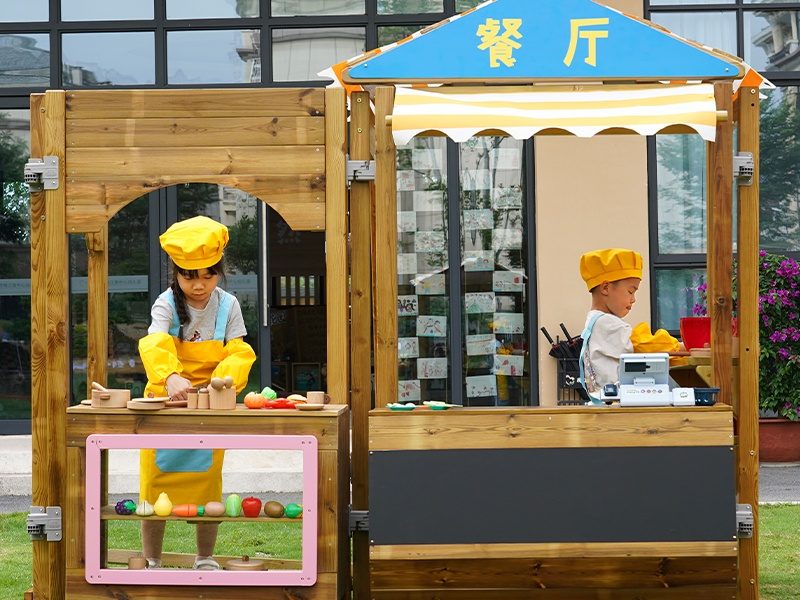
Social and Emotional Growth
Pretend play activities for toddlers and preschoolers provide a safe space to explore emotions and practice social interactions. Research from Western Governors University highlights how children develop:
- Empathy – By “walking in someone else’s shoes” through role-playing
- Emotional regulation – Processing feelings through pretend scenarios
- Conflict resolution – Negotiating disagreements during cooperative play
- Self-confidence – Discovering they can be anything through imagination
Language and Literacy Skills
Every pretend play scenario becomes a rich language-learning opportunity. Children naturally:
- Use new vocabulary words in context
- Practice conversational skills
- Understand that print carries meaning (through props like menus, signs, labels)
- Develop narrative skills by creating play storylines
Physical Development and Motor Skills
While often overlooked, pretend play activities for preschoolers significantly contribute to fine and gross motor development. Children practicing as pretend chefs, doctors, or shop owners constantly use:
- Fine motor skills – Manipulating small toys, writing pretend prescriptions, handling play money
- Gross motor skills – Moving around play spaces, carrying items, acting out physical roles
- Hand-eye coordination – Pouring pretend tea, stacking play food, organizing materials
Best Pretend Play Ideas for Different Ages
Understanding the dramatic play age progression helps educators and parents provide developmentally appropriate pretend play ideas.
Pretend Play Activities for Infants and Toddlers (12-24 months)
At this early stage, dramatic play activities for infants and toddlers are simple and exploratory:
- Telephone play – Holding objects to ear and “talking”
- Feeding dolls or stuffed animals – Using spoons and cups
- Simple imitation – Copying adult actions like sweeping or cooking
- Exploring cause and effect – Putting objects in containers, stacking blocks
Toddlers need tangible placeholder objects—they cannot yet pretend with empty hands. High-quality wooden toys work exceptionally well because they’re durable, safe, and encourage open-ended play.
Pretend Play Ideas for 2 Year Olds (24-36 months)
Pretend play ideas for 2 year olds become more elaborate as symbolic thinking emerges:
- Playing house – Caring for baby dolls, cooking pretend meals
- Vehicle play – Driving toy cars with sound effects
- Animal pretend – Acting like different animals
- Simple role-playing – Being “mommy” or “daddy”
Research from early childhood development resources shows that 18-month-olds begin combining objects meaningfully, while 2-year-olds can sustain pretend play scenarios for several minutes.
Pretend Play Activities for Preschoolers (3-5 years)
This is the golden age for pretend play activities for preschoolers. Children can now:
- Create complex play scenarios with multiple steps
- Sustain play themes for extended periods
- Cooperate with peers in shared pretend worlds
- Use sophisticated language in role-playing
- Understand and follow self-created “rules” for play scenarios
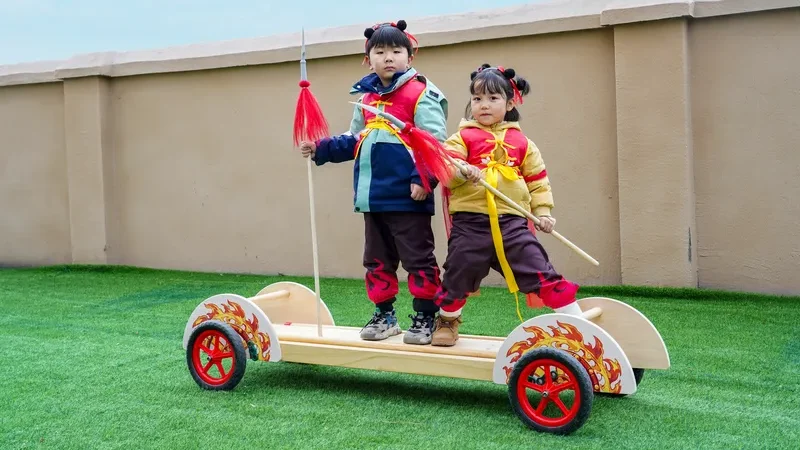
Setting Up Dramatic Play Area Preschool Environments
Creating an engaging dramatic play area preschool space doesn’t require expensive materials. Here’s how to design effective centers:
Essential Elements of a Dramatic Play Center
Every successful dramatic play area should include:
- Defined Space – Clear boundaries help children understand the play area
- Accessible Storage – Organized bins and shelves for materials
- Relevant Props – Items that support the chosen theme
- Literacy Elements – Signs, labels, writing materials
- Math Opportunities – Items for counting, sorting, measuring
Creating Print-Rich Environments
Incorporate environmental print into dramatic play center ideas for kindergarten and preschool:
- Labels – Name tags, food labels, product signs
- Writing tools – Paper, clipboards, pencils for lists and orders
- Reading materials – Menus, recipe cards, instruction manuals
- Functional text – Open/closed signs, price tags, receipts
Rotating Themes to Maintain Interest
According to Rasmussen University early childhood education experts, regularly changing dramatic play themes keeps children engaged. Consider rotating every 2-4 weeks between familiar and novel themes.
Popular Dramatic Play Center Ideas for Kindergarten and Preschool
Let’s explore specific pretend play ideas that consistently captivate young children:
1. Restaurant or Café Dramatic Play
Children love playing restaurant because eating out is a familiar experience. This dramatic play center idea supports:
- Menu reading and writing
- Taking orders and serving customers
- Money handling and basic math
- Social etiquette and manners
Materials needed:
- Play kitchen or cooking area
- Wooden play food (fruits, vegetables, dishes)
- Menus (printed or child-created)
- Cash register and play money
- Serving trays and utensils
- Aprons and chef hats

2. Doctor’s Office or Hospital Play
Medical play helps children process healthcare experiences and reduces anxiety about doctor visits. Child development research shows this builds empathy and caregiving skills.
Setup ideas:
- Waiting area with chairs and magazines
- Examination table (bench or small table)
- Medical kit with toy stethoscope, thermometer, bandages
- Appointment book for scheduling
- Patient charts for writing observations
3. School or Library Dramatic Play
Playing school allows children to practice both student and teacher roles, building confidence for their own educational journey.
Materials needed:
- Small chalkboard or whiteboard
- Books on shelves
- Paper and writing materials
- Bell or timer for class changes
- Student desks or table setup
- Teacher’s desk with supplies
4. Post Office or Mail Center
This dramatic play center idea for kindergarten incorporates authentic literacy experiences:
- Writing letters and addresses
- Sorting mail by name or address
- Using stamps and stickers
- Delivering packages
- Reading return addresses
5. Construction Site Dramatic Play
Perfect for active learners who love building:
- Hard hats and tool belts
- Wooden blocks and construction toys
- Blueprint papers for planning
- Measuring tape and ruler
- Toy trucks and vehicles
- Safety signs
Grocery Store Dramatic Play Ideas: Complete Setup Guide
Grocery store dramatic play ideas are consistently popular because shopping is a weekly routine most children experience. This familiar theme provides rich learning opportunities across all developmental domains.
Why Grocery Stores Work So Well
According to early childhood educators, grocery stores are ideal starting dramatic play themes because:
- Children have extensive real-life experience
- Natural math integration (counting, sorting, money)
- Abundant literacy opportunities (labels, lists, signs)
- Supports healthy eating discussions
- Engages diverse learners with multiple roles
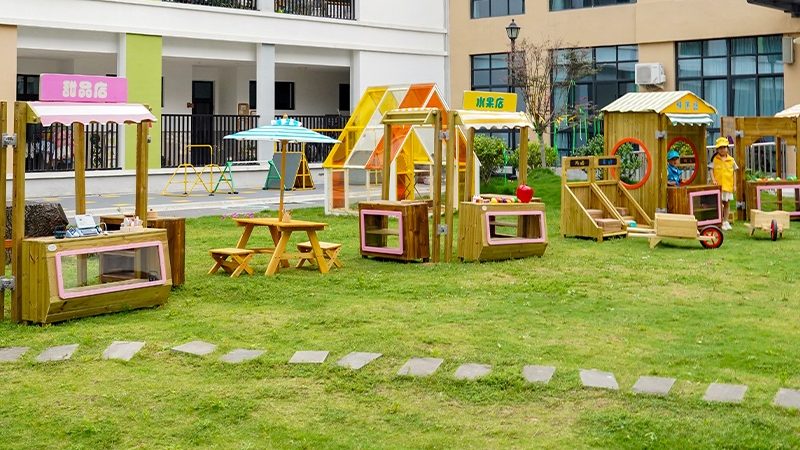
Setting Up Your Grocery Store Dramatic Play Center
Essential Components:
- Shelving Units – Organize different “departments”
- Produce section with fruits and vegetables
- Pantry items (canned goods, boxes)
- Refrigerated section
- Frozen foods area
- Shopping Tools
- Child-sized shopping carts or baskets
- Reusable shopping bags
- Shopping lists on clipboards
- Checkout Area
- Cash register (wooden or toy)
- Play money and credit cards
- Receipt paper and pens
- Scanning device (toy or cardboard)
- Products and Pricing
- Wooden play food sets
- Empty food containers (cleaned and safe)
- Price tags and sale signs
- Store circulars/advertisements
Budget-Friendly Grocery Store Ideas
Following advice from Pocket of Preschool educators, you can create an amazing grocery store without breaking the bank:
Free or Low-Cost Options:
- Empty cereal boxes, milk cartons, egg cartons
- Food boxes from your recycling bin
- Homemade play food from felt or cardboard
- Price tags printed on cardstock
- Reusable shopping bags from promotions
Learning Opportunities in Grocery Store Play
Math Skills:
- Counting items
- Sorting by category, color, or type
- Adding prices
- Making change
- Comparing quantities
Literacy Skills:
- Reading environmental print (brand names, labels)
- Writing shopping lists
- Following recipes
- Reading prices and sale signs
Life Skills:
- Healthy food choices
- Budgeting and money management
- Customer service interactions
- Organization and categorization
Flower Shop Dramatic Play Ideas: Bringing Nature Indoors
Flower shop dramatic play ideas are perfect for spring themes or plant study units. This elegant theme combines art, science, and business concepts.
Benefits of Flower Shop Pretend Play
Educational research from Play to Learn Preschool demonstrates that flower shop dramatic play provides:
- Fine motor practice – Arranging stems, wrapping bouquets, cutting ribbon
- Color recognition and sorting – Organizing flowers by color
- Scientific observation – Learning about plant parts and growth
- Artistic expression – Creating beautiful arrangements
- Business concepts – Understanding commerce and customer service

Setting Up Your Flower Shop
Materials and Setup:
- Flower Selection
- Dollar store artificial flowers (cut stems individually)
- Wooden flowers (durable for repeated play)
- Paper flowers (child-made for extra engagement)
- Real flowers occasionally for sensory experience
- Display Area
- Small vases, tin cans, or plastic containers
- Wooden crates or shelves for displaying
- Flower “seeds” (pom poms or beads) for planting section
- Potting soil (real or crinkle paper)
- Florist Tools
- Child-safe scissors
- Ribbons and bows for wrapping
- Tissue paper or cellophane for bouquets
- Spray bottles for “watering”
- Gardening gloves and small tools
- Business Components
- Cash register and flower-themed money
- Price tags and sale signs
- Order forms for custom arrangements
- Greeting cards for special occasions
- Delivery bags or boxes
Creative Flower Shop Activities
Following recommendations from early childhood specialists:
Planting Station: Children “plant” pom pom seeds in small pots with brown crinkle paper soil, water them with spray bottles, and watch them “grow” into colorful flowers.
Custom Orders: Customers fill out order forms specifying:
- Number of flowers
- Colors desired
- Occasion (birthday, thank you, etc.)
- Delivery or pickup
Color Sorting Challenge: Organize flowers by color into different vases or containers, reinforcing color recognition and classification skills.
Card Creation: Provide blank cards where children can write messages and draw pictures to accompany bouquets, integrating writing practice naturally.
Connecting to Science Learning
Flower shop dramatic play ideas naturally extend into science concepts:
- Plant life cycles – From seed to flower
- Parts of a plant – Roots, stems, leaves, petals
- Photosynthesis – Basic understanding of plant needs
- Pollination – Role of bees and butterflies
- Seasons – When different flowers bloom
Pretend Play Activities for Toddlers: Age-Appropriate Ideas
Pretend play activities for toddlers require special consideration since younger children are just beginning to develop symbolic thinking abilities.
Understanding Toddler Developmental Stages
According to child development research:
- 12-18 months – Simple imitation of adult actions
- 18-24 months – Combining objects (spoon in bowl)
- 2-3 years – Sustained pretend play with props
- 3-4 years – Cooperative pretend play with peers
Simple Pretend Play Ideas for 2 Year Olds and Younger
1. Telephone Play Even infants enjoy holding objects to their ear and “talking.” Provide:
- Toy phones
- Blocks shaped like phones
- Old (disconnected) real phones
2. Feeding Play Toddlers love caring for babies and stuffed animals:
- Baby dolls with bottles
- Toy dishes and utensils
- Wooden play food
- Pretend high chairs
3. Cleaning and Housework Toddlers want to help with real chores:
- Child-sized broom and dustpan
- Toy vacuum cleaner
- Spray bottles (empty) and cloths
- Toy washing machine or sink
4. Doctor Play Simple medical play helps toddlers process doctor visits:
- Stethoscope
- Bandages
- Thermometer
- Medicine droppers (empty)
5. Vehicle Play Moving vehicles with sound effects:
- Wooden cars and trucks
- Building ramps and roads
- Making vehicle sounds
- Pretend gas station
Tips for Engaging Toddlers in Pretend Play
Research from Sprout Organics offers these evidence-based tips:
- Play alongside them – Toddlers need modeling
- Use real objects – Actual kitchen items when safe
- Keep it simple – Don’t over-complicate scenarios
- Follow their lead – Let them direct the play
- Provide placeholder objects – Toddlers can’t pretend with empty hands
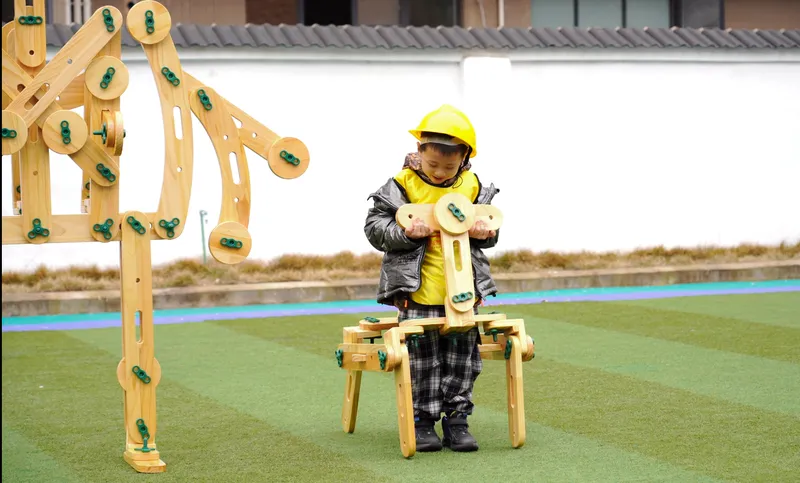
Tips for Encouraging Imaginative Play at Home and School
Whether you’re an educator or parent, these strategies will help maximize pretend play activities for preschoolers.
Creating Time and Space for Pretend Play
According to child development experts at DuPage Children’s Museum:
- Dedicate daily time – At least 30-45 minutes of uninterrupted play
- Minimize distractions – Turn off screens during pretend play time
- Provide adequate space – Room to move and set up scenarios
- Keep materials accessible – Organized but easy to reach
Adult Participation in Pretend Play
Research shows that toddlers and preschoolers engage in more pretend play when adults participate:
How to Play Along Effectively:
- Take supporting roles – Let children lead
- Ask open-ended questions – “What should we do next?”
- Model new vocabulary – Introduce theme-related words naturally
- Respect their storylines – Don’t over-direct the play
- Show genuine interest – Enthusiasm is contagious
Selecting Quality Props and Materials
High-quality wooden educational toys offer unique advantages for pretend play:
Benefits of Wooden Toys:
- Durability – Last for years of play
- Safety – Non-toxic, no sharp edges
- Open-ended – Encourage creativity
- Aesthetic appeal – Beautiful and inviting
- Environmental – Sustainable choice
- Sensory qualities – Pleasant texture and weight
Essential Props for Versatile Pretend Play:
- Wooden play food sets
- Dress-up clothes and accessories
- Play dishes and kitchen items
- Dolls and stuffed animals
- Vehicles and community figures
- Building blocks and construction materials
Observing and Extending Play
Smart educators use observation to enhance pretend play activities for preschoolers:
- Watch for interests – Notice repeated themes
- Document play – Take photos for portfolios
- Ask families – Learn about home experiences
- Add relevant props – Support emerging themes
- Connect to curriculum – Integrate learning objectives
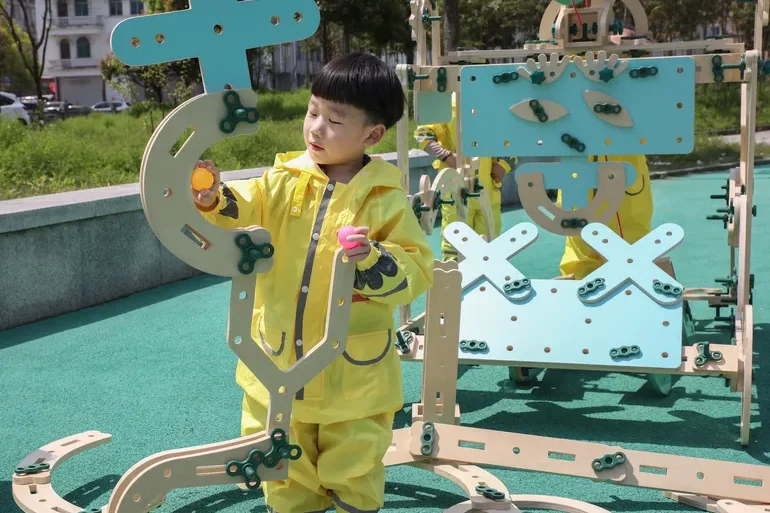
Inclusive Pretend Play: Supporting All Learners
Effective dramatic play center ideas for kindergarten and preschool must accommodate diverse learners.
Adaptations for Children with Special Needs
- Visual supports – Picture schedules and labeled storage
- Sensory considerations – Quiet spaces, various textures
- Physical accessibility – Adjustable heights, wide pathways
- Communication supports – Visual choice boards, simple language
- Predictable routines – Consistent play center organization
Cultural Responsiveness in Pretend Play
Research from early childhood diversity experts emphasizes:
- Diverse representation – Dolls, books, and props reflecting various cultures
- Family involvement – Ask families to contribute culturally relevant items
- Multiple languages – Labels and signs in home languages
- Varied scenarios – Play themes from different cultural perspectives
- Authentic materials – Real items from various cultures when appropriate
Troubleshooting Common Pretend Play Challenges
“My child doesn’t know how to pretend play”
Some children need extra support developing imaginative play skills:
Solutions:
- Start with familiar routines (bedtime, mealtime)
- Use books as springboards for play scenarios
- Demonstrate simple pretend actions
- Play alongside them without taking over
- Be patient – skills develop at different rates
“The play becomes too wild or aggressive”
Active play can sometimes escalate:
Management Strategies:
- Establish clear safety rules
- Provide alternative active outlets
- Redirect to calmer play themes
- Discuss feelings and appropriate expression
- Set up “cool down” spaces
“Children won’t share or take turns in dramatic play”
Social skills develop through practice:
Teaching Strategies:
- Use role cards to rotate roles
- Set timers for turn-taking
- Model sharing language
- Praise cooperative behavior
- Create multiple roles so all can participate
Research-Backed Benefits: Why Invest in Quality Pretend Play Materials
Academic Readiness Through Play
Longitudinal studies demonstrate that children who engage in rich pretend play:
- Enter kindergarten with stronger pre-literacy skills
- Demonstrate better problem-solving abilities
- Show enhanced self-regulation
- Exhibit more advanced language development
- Display stronger social competence
Long-Term Impact on Executive Function
Dramatic play directly supports executive function development – the cognitive skills crucial for:
- Planning and organization
- Working memory
- Cognitive flexibility
- Impulse control
- Task initiation and completion
These skills predict academic success more reliably than early reading or math abilities.
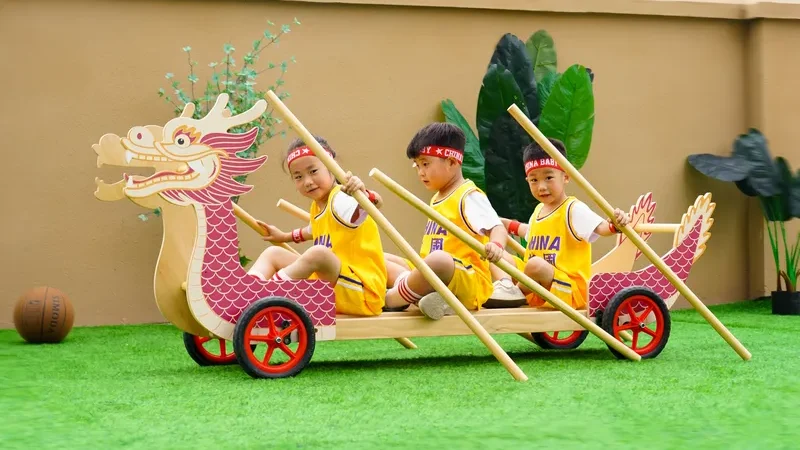
Seasonal and Themed Pretend Play Ideas
Spring Pretend Play Activities
- Flower shop (detailed above)
- Garden center with planting
- Farmer’s market
- Rain gear and puddle play
- Baby animal nursery
Summer Pretend Play Ideas
- Beach vacation
- Ice cream shop
- Camping adventure
- Outdoor restaurant
- Car wash
Fall Pretend Play Activities
- Apple orchard
- Pumpkin patch
- Bakery (fall treats)
- Harvest festival
- Cozy café
Winter Pretend Play Ideas
- Hot chocolate shop
- Ski lodge
- Post office (holiday cards)
- Gift wrapping station
- Bakery (holiday cookies)
Conclusion: The Lasting Power of Pretend Play
Pretend play activities for preschoolers are not just entertaining diversions – they’re essential developmental experiences that build the foundation for lifelong learning and success. Whether children are running a grocery store dramatic play center, arranging flowers in a flower shop, or caring for baby dolls, they’re actively constructing knowledge, practicing social skills, and developing the cognitive flexibility that will serve them throughout their educational journey and beyond.
Key Takeaways
- Pretend play is essential – Not optional enrichment, but core curriculum
- Quality materials matter – Wooden toys and thoughtful props enhance play
- Adult support is valuable – Model, participate, but don’t dominate
- All children benefit – Pretend play supports diverse learners
- Simple setups work – Elaborate isn’t necessary; engagement is
Taking Action
As educators and parents, we have the privilege and responsibility to protect and nurture imaginative play in children’s lives. By providing:
- Time for unhurried pretend play
- Space for safe exploration
- Materials that inspire creativity
- Support without over-direction
- Respect for children’s play choices
We give children the gift of childhood while simultaneously preparing them for future success.

About Our Wooden Educational Toys
At Sing2sky, we understand the critical role that high-quality play materials serve in children’s development. Our carefully crafted wooden educational toys are designed specifically to support pretend play activities for preschoolers, combining:
- Safety – Non-toxic materials and smooth finishes
- Durability – Built to withstand years of active play
- Educational value – Aligned with early childhood development standards
- Aesthetic appeal – Beautiful designs that inspire imagination
- Sustainability – Environmentally responsible materials
Whether you’re equipping a preschool dramatic play area, setting up a home play space, or selecting toys for your educational institution, our wooden toys provide the foundation for rich, engaging pretend play experiences.
Contact us today to learn more about our wholesale options for preschools, kindergartens, and educational distributors worldwide.